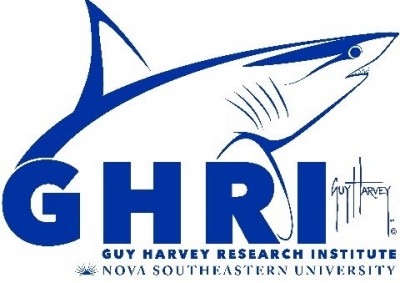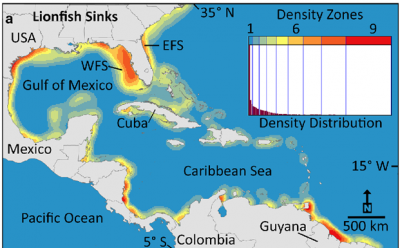NSU Newsroom
SharkBytes
Horizons
This version of NSU News has been archived as of February 28, 2019. To search through archived articles, visit nova.edu/search. To access the new version of NSU News, visit news.nova.edu.
This version of SharkBytes has been archived as of February 28, 2019. To search through archived articles, visit nova.edu/search. To access the new version of SharkBytes, visit sharkbytes.nova.edu.
Spread of Lionfish in Gulf of Mexico is Threat to Reef Fisheries
Invasive Species Has Potential to Deliver Negative Economic Impact
FOR IMMEDIATE RELEASE
 FORT LAUDERDALE/DAVIE, Fla. – As the old saying goes: “You can’t put the genie back in the bottle.”
FORT LAUDERDALE/DAVIE, Fla. – As the old saying goes: “You can’t put the genie back in the bottle.”
Nowhere is this more evident than with the spread of lionfish, an invasive, non-native species that is threatening the marine ecosystems across the Gulf of Mexico, Caribbean and Atlantic Ocean. And one researcher at Nova Southeastern University (NSU) continues working to learn as much about lionfish as he can.
“I’ve been studying this specific invasive species for many years and it’s clear the threat it poses to our reefs and marine environment is real,” said Matthew Johnston, Ph.D., a research scientist at NSU’s Halmos College of Natural Sciences and Oceanography. “As with all
invasives, without any natural predators to keep things in balance, the one species can come to dominate the others.”
 Johnston is also a member of the NSU Guy Harvey Research Institute (GHRI) research team. His latest research paper, published by the journal Coral Reefs, can be viewed ONLINE.
Johnston is also a member of the NSU Guy Harvey Research Institute (GHRI) research team. His latest research paper, published by the journal Coral Reefs, can be viewed ONLINE.
In his latest study, Johnston said that lionfish now permeate the entire tropical western Atlantic, Caribbean and Gulf of Mexico, but their numbers have been surveyed only in select locations in the field. What hasn’t been shown is their potential abundance and the related effect high lionfish numbers may have on the “economically important” reef fishes. It is this data that is needed – and quickly – to help mitigate the damage lionfish could cause.
Johnston said that whenever researchers examine a lionfish specimen they are finding all sorts of juvenile fish they’ve eaten, and therein lies the problem. With no natural predators to keep lionfish in check, they are free to reproduce in great numbers. Couple that with their propensity to eat a significant quantity of juvenile fish, it’s only a matter of time until those other fish species start to see a decline in their numbers on the reef.
According to the study, the west Florida shelf and the entire offshore Texas coast could be on the verge of seeing dramatically high densities of lionfish, based on ocean conditions (water flow, etc.,) which help spread the invasive species and concentrate them to new areas. Johnston said that the west Florida Shelf is a high-production fishery, especially for red grouper, and that projection model shows the grouper in areas that are expected to have high lionfish populations in the future.
 “It’s a never-ending battle as we’ll never fully eradicate lionfish from our waters,” Johnston said. “What we need to do is not only understand where they are right now but also work to forecast where they will be in the future. We also need to identify better ways of controlling their numbers, especially in deep water.”
“It’s a never-ending battle as we’ll never fully eradicate lionfish from our waters,” Johnston said. “What we need to do is not only understand where they are right now but also work to forecast where they will be in the future. We also need to identify better ways of controlling their numbers, especially in deep water.”
Johnston understands that for many people, this threat doesn’t resonate.
“We’re talking millions of dollars in the fishing industries – from catching and selling various fish to the hundreds of thousands of jobs and the recreational aspects of fishing,” he said. “If left unchecked, there is the real potential that lionfish will have a negative impact on the fishing industry. After all, they are eating the same fish that our grouper and snapper rely on for food, and sometimes even the baby grouper and snapper themselves. In other words, it’s likely that they are negatively impacting populations of the fish we like to eat, and at an alarming rate. That’s why we must work to keep them under control so their impact on other fish is kept as reasonable as possible”
Johnston has published other studies related to the spread of lionfish. You can read more about Johnston’s research online:
- More Culling Needed to Reduce Lionfish Invasion
- Invasive Species Benefit from Changes in Ocean Currents During Storms
- View a Video of NSU Researchers Discussing Study of Lionfish and Tropical Storms
Be sure to sign up for NSU’s RSS feed so you don’t miss any of our news releases, guest editorials and other announcements. Please sign up HERE.
###
About Nova Southeastern University (NSU): Located in beautiful Fort Lauderdale, Florida, Nova Southeastern University (NSU) is a dynamic research institution dedicated to providing high-quality educational programs at the undergraduate, graduate, and first-professional degree levels. A private, not-for-profit institution, NSU has campuses in Fort Lauderdale, Fort Myers, Jacksonville, Miami, Miramar, Orlando, Palm Beach, and Tampa, Florida, as well as San Juan, Puerto Rico, while maintaining a presence online globally. For more than 50 years, NSU has been awarding degrees in a wide range of fields, while fostering groundbreaking research and an impactful commitment to community. Classified as a research university with “high research activity” by the Carnegie Foundation for the Advancement of Teaching, NSU is 1 of only 50 universities nationwide to also be awarded Carnegie’s Community Engagement Classification, and is also the largest private, not-for-profit institution in the United States that meets the U.S. Department of Education’s criteria as a Hispanic-serving Institution. Please visit www.nova.edu for more information about NSU and realizingpotential.nova.edu for more information on the largest fundraising campaign in NSU history.
About NSU’s Halmos College of Natural Sciences and Oceanography: The college provides high-quality undergraduate (bachelor’s degree) and graduate (master’s and doctoral degrees and certificates) education programs in a broad range of disciplines, including marine sciences, mathematics, biophysics, and chemistry. Researchers carry out innovative basic and applied research programs in coral reef biology, ecology, and geology; fish biology, ecology, and conservation; shark and billfish ecology; fisheries science; deep-sea organismal biology and ecology; invertebrate and vertebrate genomics, genetics, molecular ecology, and evolution; microbiology; biodiversity; observation and modeling of large-scale ocean circulation, coastal dynamics, and ocean atmosphere coupling; benthic habitat mapping; biodiversity; histology; and calcification. The college’s newest building is the state-of-the-art Guy Harvey Oceanographic Center, an 86,000-square-foot structure filled with laboratories; offices; seminar rooms; an auditorium; and indoor and outdoor running sea water facilities. Please visit cnso.nova.edu for more information.
February 14, 2017
Joe Donzelli | Office of Public Affairs
954-262-2159 (office) | 954-661-4571 (cell)
jdonzelli@nova.edu | www.nova.edu